Emily Dawson has written a report on Material Beliefs, which you can download here (PDF). This report was commissioned for the EPSRC (the project funder) and the project participants, and will be useful if you want to have a closer look at what the project aimed to do, and what it actually did.
Thanks to those who contributed, to the report and to the project. For those of us with short attention spans, some of the report features are summarised on the EPSRC grant page.
Posted by wordpress · background, event · leave comment »
This post is to introduce myself, I’m David Muth, a musician, programmer and artist who lives and works in London.
I joined the Neural Animat team a couple of months ago, and have been working on algorithmic visualisations of neural activity. This project is of particular interest to me, as it touches on philosophical questions about consciousness and decision making.
The method of writing computer code in order to generate imagery in real time has been of relevance to quite a few of my projects. If you’d like to find out a little bit more, please have a look at my website.
Posted by David · background, process · leave comment »
This was an evening event at the Royal Institution of Great Britain providing a conversation between participants of the Crossing Over exhibition and members of the public.
Initiated by facilitator Mark Lythgoe, a start point was the separation of science and humanities, as argued by C. P. Snow in his Two Cultures lecture of 1959. A discussion of collaborations that tried to cross Snow’s fences, moved on to some thoughtful attendee comments about the requirements and expectations of role and institution, rather than essentialist differences between practitioner types.
In this light I was reminded that the potential value of sci-art is not to do with the inspiring effect of art’s lens upon science methods, nor the nourishment of art practice by science outcomes, but rather the value of collaborative practice as it provides the resources and the time for people to do things that they might not ordinarily do, with people they might not usually meet.
Additionally, if these collaborations are transparent, and performed amongst the public, they start to work upon divisions between specialists and non-specialists, which is perhaps a more relevant division within contemporary society than Snow’s two cultures.
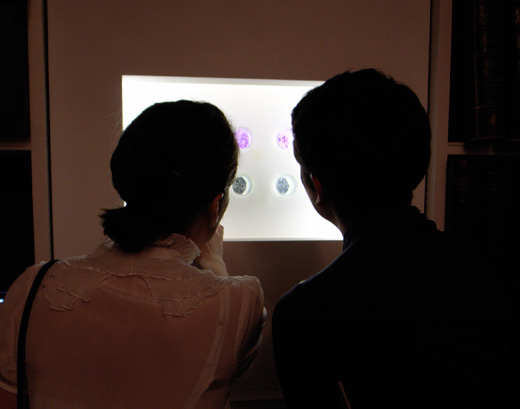
Above: the Bansai Cells project lets researchers discuss their work with different audiences
Posted by wordpress · background, event, process · leave comment »
Material Beliefs showed three posters at the Arts & Technology symposium on October 14th at the National Theatre, organised by BioCentre. Here’s a quote from the BioCentre event page:
How can the arts conversation shape and develop public policy? Do the arts add to the hype or do they really help to inform the public of the truth about these issues? Can the arts and public policy arenas work more closely to further enrich the dialogue? If so, how? What can policy makers learn from the arts in this area?
Material Beliefs has been funded by a Partnerships for Public Engagement award, and is trying to do events that encourage a dialogue between biomedical researchers and members of the public. A key aim is to make labs permeable, to help researchers take their interests out into cultural contexts, and to use creative engagement to provide routes into labs for members of the publics.
The introductory poster shown at the BioCentre event talks about this aim in more detail. While attendees explored an exhibition at the National Theatre event, the poster contextualised two projects that have come out of the Material Beliefs collaborations, Vital Signs and Neuroscope.
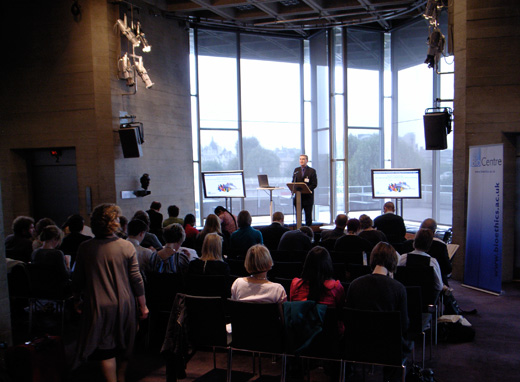
Above: Matt James from BioCentre welcomes attendees to the National Theatre
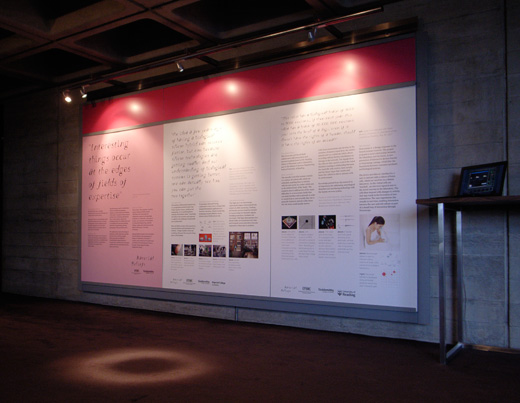
Above: Material Beliefs posters
Posted by wordpress · background, process · leave comment »
The STEM directories are launched today, in the Gallery at the Foresight Centre at the University of Liverpool, to link with the BA Festival of Science programme. The directories are a source of enrichment and enhancement activities for Science, Technology, Engineering and Mathematics curriculum at schools and colleges across the UK:
The STEM Directories have been created in direct response to teachers needs. They comprise a collection of schemes and activities provided by organisations from across the UK that aim to enhance and enrich the curriculum. These schemes are usually based around events or experiences that cannot be delivered with standard school contacts and resources
Material Beliefs is listed in the Engineering and Technology directory, with 91 regional and UK wide entries. Get in touch with us if you want Material Beliefs to help with a workshop, presentation or other schools event…

Posted by wordpress · background, process · leave comment »
Dr. Anders Sandberg is a Swedish neuroscientist, science debater, futurist, transhumanist, and author. He is currently postdoctoral research assistant for the Oxford group of the EU ENHANCE Project at the Uehiro Centre for Practical Ethics and research associate at the Future of Humanity Institute (Faculty of Philosophy, Oxford University).
Find out more about Anders’ research, through his conversation with Susana Soares, filmed by Steve Jackman.

above: Anders Sandberg with Susana Soares, filmed by Steve Jackman
Posted by wordpress · background, event · leave comment »
One of the projects coming out of collaborations within Material Beliefs is Carnivorous Domestic Entertainment Robots. Jimmy, James and Alex have been designing and building these, and images and film of the final objects will follow soon. They say:
In the context of the home, definitions of what a robot is and could be are open for interpretation. These robots are devices for utility, drama and entertainment.
For now here’s a page describing the project in some more detail, including drawings and renders. See more projects from Jimmy and James at the Auger Loizeau site.
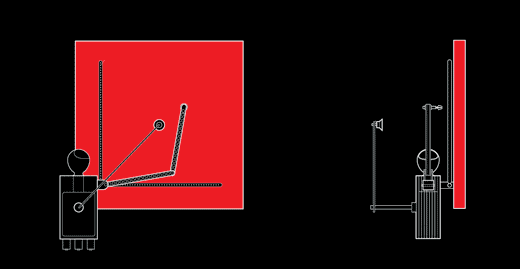
Posted by wordpress · background, process · leave comment »
The DIUS have a widget on their Science and Society site that allows you to build your own questionnaire, here’s one for Material Beliefs:
I came across this at Wired’s blog where the author comments:
Although their website is disorganized and bloated with clips of elite people saying uninteresting things, the effort is noble, and it looks like they really do need a lot of help
This makes me think that the Material Beliefs site could do with a bit of pruning and rationalisation itself, stand by for some changes.
Posted by wordpress · background, process · leave comment »
I thought I’d use my first entry to introduce myself. My name is Alex Zivanovic and I’m a freelance robotics/mechatronics/electronics/computing consultant and I’m collaborating with the Material Belief’s team.
My background is in engineering, specifically robotics, having done a PhD and postdoc research at Imperial College London on medical robotics. Over the last few years I have become interested in the artistic side of robotics, particularly, robots as interactive sculpture. I have carried out research into the work of the artist Edward Ihnatowicz, particularly the Senster and have made a website about it.
I teach workshops on using the Arduino (a microcontroller aimed at artists and designers), for Tinker.it. In particular, I run one on using actuators.
I teach one day a week at the Royal College of Art on the Design Products course, helping the students incorporate electronics into their products.
I also carry out commissions for artists wishing to use mechatronics in their work.
You can find more information about me on my website.
Posted by Alex Zivanovic · background · Comments Off on Alex’s first post: about myself
The neurally controlled animat consists of a culture of cortical cells which interact with the real world. The cells are in a lab, and become embodied by controlling a robot which acts as the artificial body of the remote ‘brain’. The robot is able to sense it’s surroundings, and pass this information back to the culture of cells. This creates a feedback loop between the cells and the robot.
This page provides more detail about the project…
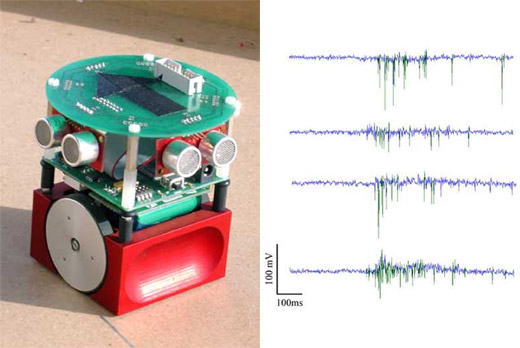
Posted by wordpress · background · leave comment »






